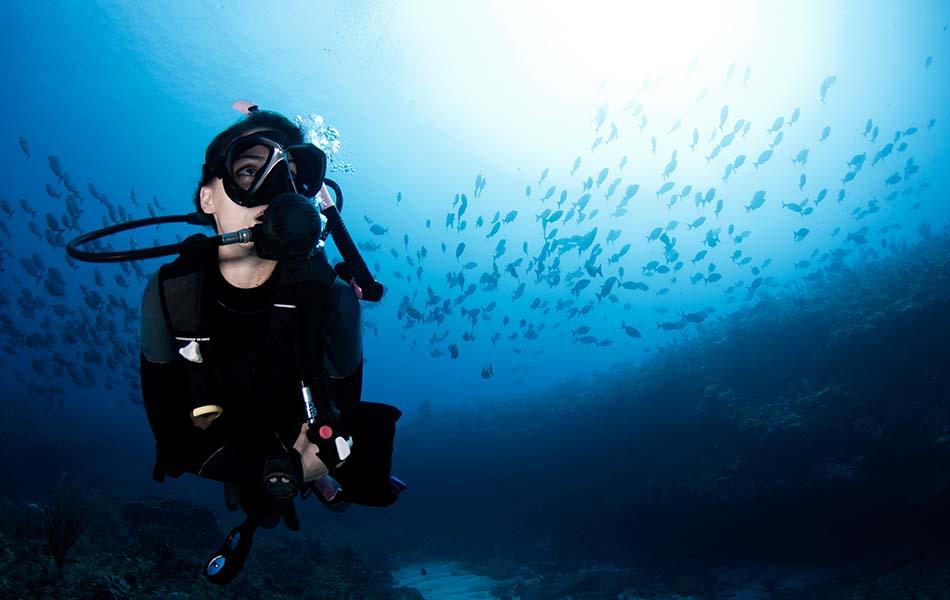
Michelle Haywood takes a deep dive into the extraordinary vision of the humble scallop...
The Isle of Man has established itself an excellent reputation for well-managed scallop fisheries. The Crown Dependency has its own political system and control over its territorial seas. Buoyed by the research carried out in the Liverpool University Marine Lab based in Port Erin, there was a pioneering project to close an area of the seabed over 30 years ago. Port Erin Closed Area was the first study to show that closed areas could enhance fisheries by providing a breeding ground where overspill would populate adjoining fishing grounds. But the scallops saw it coming...
Molluscs have evolved some sort of eye many times over. Some have compound eyes (a bit like an insect). There are a wide range of different structures and special light-sensitive proteins in play across various species. Scallops have up to 200 eyes, each about 1mm in size along the edge of their mantle. And scallop eyes are very different to our own in structure.
In our eyes, the retina sits at the back of the eye and special light-responsive proteins in our cone and rod cells absorb the light. Behind that, a dark-pigmented sclera prevents any light from being reflected. In the scallop, eye light passes through a cornea, through a pupil and lens and through two retinas before it hits a mirror at the back. Yep, a mirror.
The mirrored layer is made from crystals of guanine. That’s the same molecule that makes up part of DNA (the G of the ATCG pieces). There are 20-30 layers of guanine crystals arranged in closely tiled plates, like a mosaic. These crystals reflect light around 500nm wavelengths exceptionally well. The mirror later reflects the light onto the inside surface of the proximal (closest) and distal (furthest away) retinas.
This in turn generates a signal to the optic nerve, which connects to the scallop’s adductor muscle. That’s the bit that you eat – its primary function is to pull the two shells together for either closing the shell or propulsion. So as a diver (or other predator) swims over a scallop, the scallop senses that and closes its shell.
So, the scallop has an eye that is more akin to the structure of a telescope than that of the human eye. It is effectively a reflective mirror sending all the light onto two retinas. The images on the distal retina are better focussed than the ones on the proximal retina, so this is how scallops discern shapes. The proximal retina is more sensitive to light levels and becomes more important at night.
The scallop has an eye that is more akin to the structure of a telescope than that of the human eye.
Light is detected by opsins, light-sensitive proteins that change shape when a photon of light hits them. Humans have four opsins. Scallops have 12. These proteins are so important to scallop survival that the genes have been duplicated and over time those copies have mutated slightly. The end result of these changes is to generate novel opsin proteins that can respond to different wavelengths of light. It’s not quite technicolour vision, but it’s close. Having 12 opsins increases the scallop’s ability to detect changes in the environment, such as incoming predators (aka divers) and respond accordingly.
Scallop eyes aren’t just responding to light and dark. We’ve all seen scallops close without any shadow falling on them. Scallops are capable of spatial vision. Each retina has different photoreceptor cells with different opsins. The lens of the eye isn’t totally in line with the mirrored layer. This allows the scallop eyes to focus at different distances, something we achieve by changing the shape of our lens. Scallops can also adjust the amount of light entering by changing the size of their pupil so that the light-sensitive proteins don’t become overwhelmed.
Scallops sense their environment in a way that directs where they will move to. They can look at different substrates and swim towards a more suitable patch of seabed. The humble scallop possesses only a rudimentary nervous system with a few bundles of ganglions. There’s no brain to think through the responses that the scallop makes. But next time you swim past a scallop, just be aware that 200 tiny eyes saw you coming, although they probably won’t remember you when you swim back past them again.
Join the BSAC community
The BSAC network is working together to keep people connected to the sport. With online training, special interest webinars, competitions, support to clubs and the trade, and much more...we'd love you to join us.
This column article was originally published in SCUBA magazine, Issue #116 July 2021. For more membership benefits, visit bsac.com/benefits.
Images in this online version may have been substituted from the original images in SCUBA magazine due to usage rights.

 Author: Michelle Haywood | Posted 18 Aug 2021
Author: Michelle Haywood | Posted 18 Aug 2021



